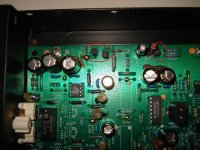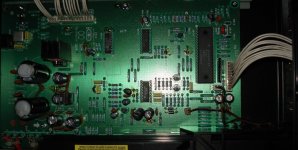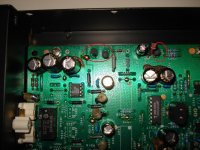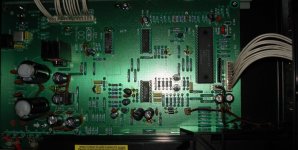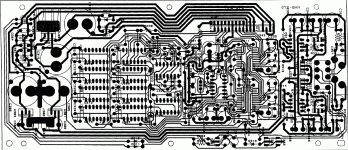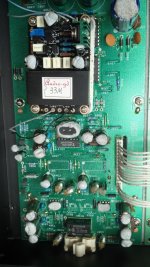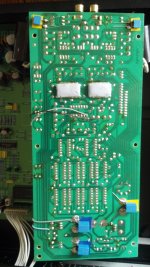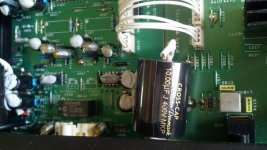Looking for advice and instructions where to start tweaking a Rotel RCD-975?
Not experienced with electronics but can solder and eager to learn in the process. Interested to get your suggestions or experience with this particular player.
Brought back this player into service recently after a speaker building project which revealed that a newer, much more expensive, well regarded CD player did not appear as good...
First explored other threads but could not find specifics for this player.
Then investigated removing attenuation components (free common tweak). Which does not appear to be applicable for this player as it uses a relay with zero effect on the audio
http://www.diyaudio.com/forums/digital-source/36610-muting-transistors-rotel-rcd-975-a.html
So which of these these further changes are worth while trying and in what order:
1. Thicker "better" copper insulated power cord. Forget adding new IEC socket just re-solder? Currently no earth wire on lead - a good thing to avoid interference?
2. Changing the two AD711JN OPAMP's (after DAC) is another the easy task. Remove and put in an 8 pin IC socket for easy testing. But what's better/different and compatible with TDA1305T filter-DAC? Only concrete recommendation for this player is to replace with LT1122
Nasotec Home Page
http://www.datasheetcatalog.org/datasheet/lineartechnology/lt1122.pdf.
Have not seen these from a supplier in Australia
Other favourites seem to be AD8065 ($13) and LM4562MA ($10). OPA627BP is comparatively at ($65) unless a sure bet. Another one that is readily available is OPA2134PA ($10). Are they all compatible with TDA1305T?
TDA1305T datasheet, Pinout ,application circuits TDA1305T Stereo 1fs Data Input Up-sampling Filter With Bitstream Continuous Dual DAC (BCC-DAC2)
3. Good decoupling and/or regulators for the supply pins of DAC chip. Does this mean feeding individually from a new power source?
4. Replacing the main PSU caps near the transformer. Because they can have degraded, better ones are available or different V/uF values required?
5. A large toroidal transformer and power supply regulators supplying the separate DAC analogue output board or individual components.
6. Bypass low value resistors carrying power supply to chips (1-4 ohms?)
7. Replace the cap(s) carrying HF to the OpAmps with higher uF and quality.
8. Replace rectifiers with fast, soft recovery and bypass with RC snubber (100ohms, 47nF).
Not sure what this achieves or means?
9. Clock upgrade. Read mixed results (minor improvements?) for a lot of effort/expense.
10. Damping and heavy coupling of spinner.
11. Top loader replacement as prevention of spinner vibrations rather than taming them (also added benefit of doing away with CDM-9 transport mechanisms maintenance). Hack of case required.
Irrespectively will dampen feet, case, PCB (with wedged cork), and cap+DAC circuits (with blue tack). There is already a rubber casing around the filter-DAC for that purpose?
Most CAPS on both boards are Black Gate or Nichigon which are supposed to be quite good. So systematically replacing may not offer much improvement.
Not experienced with electronics but can solder and eager to learn in the process. Interested to get your suggestions or experience with this particular player.
Brought back this player into service recently after a speaker building project which revealed that a newer, much more expensive, well regarded CD player did not appear as good...
First explored other threads but could not find specifics for this player.
Then investigated removing attenuation components (free common tweak). Which does not appear to be applicable for this player as it uses a relay with zero effect on the audio
http://www.diyaudio.com/forums/digital-source/36610-muting-transistors-rotel-rcd-975-a.html
So which of these these further changes are worth while trying and in what order:
1. Thicker "better" copper insulated power cord. Forget adding new IEC socket just re-solder? Currently no earth wire on lead - a good thing to avoid interference?
2. Changing the two AD711JN OPAMP's (after DAC) is another the easy task. Remove and put in an 8 pin IC socket for easy testing. But what's better/different and compatible with TDA1305T filter-DAC? Only concrete recommendation for this player is to replace with LT1122
Nasotec Home Page
http://www.datasheetcatalog.org/datasheet/lineartechnology/lt1122.pdf.
Have not seen these from a supplier in Australia
Other favourites seem to be AD8065 ($13) and LM4562MA ($10). OPA627BP is comparatively at ($65) unless a sure bet. Another one that is readily available is OPA2134PA ($10). Are they all compatible with TDA1305T?
TDA1305T datasheet, Pinout ,application circuits TDA1305T Stereo 1fs Data Input Up-sampling Filter With Bitstream Continuous Dual DAC (BCC-DAC2)
3. Good decoupling and/or regulators for the supply pins of DAC chip. Does this mean feeding individually from a new power source?
4. Replacing the main PSU caps near the transformer. Because they can have degraded, better ones are available or different V/uF values required?
5. A large toroidal transformer and power supply regulators supplying the separate DAC analogue output board or individual components.
6. Bypass low value resistors carrying power supply to chips (1-4 ohms?)
7. Replace the cap(s) carrying HF to the OpAmps with higher uF and quality.
8. Replace rectifiers with fast, soft recovery and bypass with RC snubber (100ohms, 47nF).
Not sure what this achieves or means?
9. Clock upgrade. Read mixed results (minor improvements?) for a lot of effort/expense.
10. Damping and heavy coupling of spinner.
11. Top loader replacement as prevention of spinner vibrations rather than taming them (also added benefit of doing away with CDM-9 transport mechanisms maintenance). Hack of case required.
Irrespectively will dampen feet, case, PCB (with wedged cork), and cap+DAC circuits (with blue tack). There is already a rubber casing around the filter-DAC for that purpose?
Most CAPS on both boards are Black Gate or Nichigon which are supposed to be quite good. So systematically replacing may not offer much improvement.
Attachments
Other possible mods
13. Diconecting the digital output?
14. Unplugging the display as can be done remotely by some new CD players (eg. Audiolab)
15. Replacing opamp IC's with circuit board plug-in constructed from audio graded transistors and resistors (eg. Burson "HD Audio Opamps")
13. Diconecting the digital output?
14. Unplugging the display as can be done remotely by some new CD players (eg. Audiolab)
15. Replacing opamp IC's with circuit board plug-in constructed from audio graded transistors and resistors (eg. Burson "HD Audio Opamps")
Replacing caps in output stage of CDP
17. Replacing the caps in the output stage for better quality Auricap caps (same V/uF values?).
Are these:
- the C356,C357 (see-through type next to output sockets?) CAP POLESTYRENE 160V 1000PF?
OR
- the C354, C355 Black Gate Elec. 16BGF1000 (16V/1000uF)? Which ones are most critical to change in the case of the RCD-975?
See how a little knowledge but a lot of information can be overwhelming to first modification attempts?
17. Replacing the caps in the output stage for better quality Auricap caps (same V/uF values?).
Are these:
- the C356,C357 (see-through type next to output sockets?) CAP POLESTYRENE 160V 1000PF?
OR
- the C354, C355 Black Gate Elec. 16BGF1000 (16V/1000uF)? Which ones are most critical to change in the case of the RCD-975?
See how a little knowledge but a lot of information can be overwhelming to first modification attempts?
Attachments
CDP PSU and Diode component selection
Current plan is to replace:
1. Diodes. Which Schottky diodes shall I use? Can't read what the spec is for the existing ones (Tech Manual part list reads: 9 x DIODE IN4148-86, 9 x DIODE IN4002-TB, 1 x DIODE Zener BZX79-C7V5). I understand that equal or higher values can be used?
2. PSU Caps. Installed are two Black Gate 25V 1700uF. Would the Panasonic FCs or Nichicon Muse KZ of higher 3300uF values be good options?
Manufacturers part numbers and sources in/near Australia would be appreciated?
3. Opamps AD711JN -> OPA604APG4 + cap 0.1uf across supply pins (found them from element14 supplier)
Current plan is to replace:
1. Diodes. Which Schottky diodes shall I use? Can't read what the spec is for the existing ones (Tech Manual part list reads: 9 x DIODE IN4148-86, 9 x DIODE IN4002-TB, 1 x DIODE Zener BZX79-C7V5). I understand that equal or higher values can be used?
2. PSU Caps. Installed are two Black Gate 25V 1700uF. Would the Panasonic FCs or Nichicon Muse KZ of higher 3300uF values be good options?
Manufacturers part numbers and sources in/near Australia would be appreciated?
3. Opamps AD711JN -> OPA604APG4 + cap 0.1uf across supply pins (found them from element14 supplier)
Watch out the OpAmps - do not confuse the single with dual ones! AD711 is single, LM4562 and OPA2134 are duals... The singles are LME49710 and OPA134 (I would go for OPA211).
And the caps for decopling should be 2 - each pin to the ground.
I know that it is "easy" to put just one across the supply pins, but it doesn't help, I would say that it makes things worse.
And the caps for decopling should be 2 - each pin to the ground.
I know that it is "easy" to put just one across the supply pins, but it doesn't help, I would say that it makes things worse.
Thanks for clarifying. Yes, there are currently two AD711JN singles. Maybe the first mod are a cap each across their supply pins...
What are the sound characteristics of the OPA211?
Looks like the the OPA211 is a surface mount opamp and requires a BrownDog adapter or similar? Is the OPA2111KP the DIP equivalent?
What are the sound characteristics of the OPA211?
Looks like the the OPA211 is a surface mount opamp and requires a BrownDog adapter or similar? Is the OPA2111KP the DIP equivalent?
Yes, the new high quality OpAmps are seldom packaged in DIP. I guess for economical reasons first of all, but also most of the new hi-end audio is done in SMD to minimize the circuit traces lenghts. I don't personally buy it, but... I saw it as argument.
I have the dual LM4562 in a DIP and sounds great.
PS: OPA2111KP is dual in DIP package but has nothing in comun with OP211.
I have the dual LM4562 in a DIP and sounds great.
PS: OPA2111KP is dual in DIP package but has nothing in comun with OP211.
Last edited:
HERE IS A FEW LIGHT MODS FOR THE ROTEL RCD-975
My first post
This is what I have done to my recently aquired rcd-975
1. Took out anything that said "Teapo or Jamicon" see too many of these with swollen belly's!!
2. main board p/s mods; c185 & c187 to Panasonic FK 4700uf 25volt, c181 to Panasonic FC 1200uf 16v, c183,188,189 to Panasonic FC 470uf 25v. changed these also c141,142,c148,143,c139&c117 to Panasonic FC 220uf 25v.
3. DAC board mods; changed original op amps AD711GN to AD797ANZ decoupling caps, c348,349,c352,c353 to mmk 0.47uf.
4. DAC p/s mods; d301-d304 change to hfa04tb60 HEXFred diodes, c301-304 ceramic caps are removed, c305-6 to Panasonic FC 2200uf 25v, and diodes D305-306 & D311-312 changed to 11DQ10's.
To my ears it the basic mods above made a night and day difference from stock instantly, will have to report back after a week of burning in!
BTW The op-amps are mounted on turned sockets so I could roll em easier, tried a few; opa604(WEIRD), ad825(MUSHY), opa627(VERY GOOD) but the best so far AD797
and lastly I would have prefered to use Rubycon ZL or ZLH in place of c305-6 Panasonic FC can dry out the sound
Well thats my 10 peneth, Humanben.
My first post
This is what I have done to my recently aquired rcd-975
1. Took out anything that said "Teapo or Jamicon" see too many of these with swollen belly's!!
2. main board p/s mods; c185 & c187 to Panasonic FK 4700uf 25volt, c181 to Panasonic FC 1200uf 16v, c183,188,189 to Panasonic FC 470uf 25v. changed these also c141,142,c148,143,c139&c117 to Panasonic FC 220uf 25v.
3. DAC board mods; changed original op amps AD711GN to AD797ANZ decoupling caps, c348,349,c352,c353 to mmk 0.47uf.
4. DAC p/s mods; d301-d304 change to hfa04tb60 HEXFred diodes, c301-304 ceramic caps are removed, c305-6 to Panasonic FC 2200uf 25v, and diodes D305-306 & D311-312 changed to 11DQ10's.
To my ears it the basic mods above made a night and day difference from stock instantly, will have to report back after a week of burning in!
BTW The op-amps are mounted on turned sockets so I could roll em easier, tried a few; opa604(WEIRD), ad825(MUSHY), opa627(VERY GOOD) but the best so far AD797
and lastly I would have prefered to use Rubycon ZL or ZLH in place of c305-6 Panasonic FC can dry out the sound
Well thats my 10 peneth, Humanben.
Caps removal reason
Hi Humanben,
thanks for these instructions it helped me with a plan of attack. Progressing on a similar path and will report back my results.
Can I ask why you removed c301-304 ceramic caps between the diodes and did not replace them with anything?
Cheers, Roger
Hi Humanben,
thanks for these instructions it helped me with a plan of attack. Progressing on a similar path and will report back my results.
Can I ask why you removed c301-304 ceramic caps between the diodes and did not replace them with anything?
Cheers, Roger
Phase A of mods:
A1. Main board p/s c185 & c187 to 4 x Panasonic FR 2700uF 25V (2 in parallel for each replacement). The FR claim to have same low FSR as the FM series, but with up to 10000 hours lifetime @ 105°C. Bypassed with VISHAY ROEDERSTEIN polypropylene cap 0.1µF under board.
A2. DAC p/s mods; d301-d304; d305-306 & d311-312 changed to Schottky 11DQ10 diodes.
A3. DAC p/s mod: c305-6 to Panasonic FM 2200uf 25v up to 7000 hours @ 105°C
Impressions after only a few hours running are: sound is more neutral, has an airer (lifted ceiling) feeling to mids, less shrill to high frequencies. Although the latter could be partly due to a 1 ohm resistor on tweeter added recently. Some additional depth to low frequencies although drums were always very "accurately fast". Had perhaps expected deeper bass with slight increase to 2 x 5400uF (combined) paralleled caps on p/s, but probably limited by 7" woofer and characteristics of amp (Cyrus 8vs2). Pleased with improvements so far of an already very good sound.
A1. Main board p/s c185 & c187 to 4 x Panasonic FR 2700uF 25V (2 in parallel for each replacement). The FR claim to have same low FSR as the FM series, but with up to 10000 hours lifetime @ 105°C. Bypassed with VISHAY ROEDERSTEIN polypropylene cap 0.1µF under board.
A2. DAC p/s mods; d301-d304; d305-306 & d311-312 changed to Schottky 11DQ10 diodes.
A3. DAC p/s mod: c305-6 to Panasonic FM 2200uf 25v up to 7000 hours @ 105°C
Impressions after only a few hours running are: sound is more neutral, has an airer (lifted ceiling) feeling to mids, less shrill to high frequencies. Although the latter could be partly due to a 1 ohm resistor on tweeter added recently. Some additional depth to low frequencies although drums were always very "accurately fast". Had perhaps expected deeper bass with slight increase to 2 x 5400uF (combined) paralleled caps on p/s, but probably limited by 7" woofer and characteristics of amp (Cyrus 8vs2). Pleased with improvements so far of an already very good sound.
Phase B of mods:
B1. OpAmps u317, u318 changed to AD797ANZ
B2. Main board p/s c183,188,189 changed to Panasonic FR 470uF 25V (meant to have done as part of Phase A).
A little clearer, more detail and separation between instruments, base string vibrations more naturally prolonged. Also confirmed with Fostex T50RP headphones plugged into amp.
B1. OpAmps u317, u318 changed to AD797ANZ
B2. Main board p/s c183,188,189 changed to Panasonic FR 470uF 25V (meant to have done as part of Phase A).
A little clearer, more detail and separation between instruments, base string vibrations more naturally prolonged. Also confirmed with Fostex T50RP headphones plugged into amp.
Phase C of mods:
C2. Installed the Audio-gd JZ-1 module (with combined Low jitter clock and Class A supply)
- Disconnect pin 4 of U314 (TC74HCU04AP IC). I.e. unsolder and pull/bend up
- Wire 1/3FO (11.28MHz setting on 33.86M Type 1 module) to pin 1 of U314
- Wire GND on same side as 1/3FO between ground and C330
- Wire DC input from U301 (NJM78M15 voltage regulator) pin which provides +15V
- Wire GND next to DC input of JZ-1 to negative side of capacitor C306 (next to regulator)
Sound improvements are very noticeable to say the least. In order of magnitude.
1. More separation between multiple vocals (eg backing vocals) and better instrument placement
2. Vibrations of instruments such as didgeridoos and baritone brass are more realistic/pronounced
3. Singing tones have more sounds coming from back of mouth and throat (for singers/recordings that can produce/capture those dimensions of vocals)
4. Handles percussion with more attack and settles faster
5. Little bit less congestion at HF and complex passages
Xavier Rudd's "Food In the Belly" show off these differences well.
C2. Installed the Audio-gd JZ-1 module (with combined Low jitter clock and Class A supply)
- Disconnect pin 4 of U314 (TC74HCU04AP IC). I.e. unsolder and pull/bend up
- Wire 1/3FO (11.28MHz setting on 33.86M Type 1 module) to pin 1 of U314
- Wire GND on same side as 1/3FO between ground and C330
- Wire DC input from U301 (NJM78M15 voltage regulator) pin which provides +15V
- Wire GND next to DC input of JZ-1 to negative side of capacitor C306 (next to regulator)
Sound improvements are very noticeable to say the least. In order of magnitude.
1. More separation between multiple vocals (eg backing vocals) and better instrument placement
2. Vibrations of instruments such as didgeridoos and baritone brass are more realistic/pronounced
3. Singing tones have more sounds coming from back of mouth and throat (for singers/recordings that can produce/capture those dimensions of vocals)
4. Handles percussion with more attack and settles faster
5. Little bit less congestion at HF and complex passages
Xavier Rudd's "Food In the Belly" show off these differences well.
Phase D of mod:
Replaced C354 and C355 signal path output electrolytic Rubycon BlackGate caps 100uF 16V with Jantzen 10uF 400V Cross-Caps. I believe this should give around -3dB @ 2 Hz output response.
The mids are clearer and the highs appear more pronounced. The bass is a little more subtle (less depth) but still accurate and fast.
The sound signature has changed to some degree. The Blackgates gave it a certain sound that I'm obviously used to. The sound was a bit fuller, however this could possibly be attributed to some reverb/distortion. Will have to get used to it with the other benefits seemingly outweighing this...
Had previously measured the DC after opamps and it was very low. Therefore tried without the output caps altogether (just a cutoff cap leg across holes). There was no bass at all. Can anybody tell me why? Buffer role (and a couple of other 100uF caps/ceramics to ground that have a combined function?)
Then used a pair of Wishay MKP 1841 4.7uF 160V film caps I had lying around. Still limited depth and much reduced db at lower frequencies... Hence the Jantzen 10uF Cross-Caps.
Think its amazing how much this already very good CDP has improved with all the mods. And there are more component that can be upgraded or bypassed.
Replaced C354 and C355 signal path output electrolytic Rubycon BlackGate caps 100uF 16V with Jantzen 10uF 400V Cross-Caps. I believe this should give around -3dB @ 2 Hz output response.
The mids are clearer and the highs appear more pronounced. The bass is a little more subtle (less depth) but still accurate and fast.
The sound signature has changed to some degree. The Blackgates gave it a certain sound that I'm obviously used to. The sound was a bit fuller, however this could possibly be attributed to some reverb/distortion. Will have to get used to it with the other benefits seemingly outweighing this...
Had previously measured the DC after opamps and it was very low. Therefore tried without the output caps altogether (just a cutoff cap leg across holes). There was no bass at all. Can anybody tell me why? Buffer role (and a couple of other 100uF caps/ceramics to ground that have a combined function?)
Then used a pair of Wishay MKP 1841 4.7uF 160V film caps I had lying around. Still limited depth and much reduced db at lower frequencies... Hence the Jantzen 10uF Cross-Caps.
Think its amazing how much this already very good CDP has improved with all the mods. And there are more component that can be upgraded or bypassed.
Mod photos
Modification photos showing:
1. Audio-gd low jitter clock (TCXO and Class A PSU)
2. Wishay MKP 1837 bypass caps and power feed for clock
3. Jantzen 10uF output coupling caps (Cross-Caps)
Plus lots of blue tack
Modification photos showing:
1. Audio-gd low jitter clock (TCXO and Class A PSU)
2. Wishay MKP 1837 bypass caps and power feed for clock
3. Jantzen 10uF output coupling caps (Cross-Caps)
Plus lots of blue tack
Attachments
Hello,
Beware, old thread resurrection. If you are still using this cdp then the following information might be of some use to you.
My Naim CD3.5 uses the same dac chip as yours (TDA1305) and I have quite a bit of experience in playing about with it.
Check out the TDA1305 content on this site Just one thing about music - when it hits you feel no pain - find the tda1305 stuff on the CD3.5 other mods page.
I have done all the mods on that page and some more of my own and can vouch for how successful they are.
1)improve decoupling caps
2)improve vref cap
3)dedicated regulators for each ps pin (1, 10 & 28) with pin 28 being the most important
4)I went further and put a opamp based feedback reg on the internal opamps (pin 28) and pimped up the LM317 regs on pin 1 & 10, added capacitance multipliers etc etc
5) I also gave each ps pin its own dedicated psu right back to and including separate transformers - I loved that mod.
6)On pin 28 psu line I reduced the resistor between reg and chip down to 1R. Have yet to try it on the other ps pins. I think it is important to leave some resistance in there to act as damping and avoid ringing.
The latest thing I have done is bypass the anologue output section of the cdp. The TDA1305 is beefy enough to drive what is after without an output stage (well it is in my case). You will get about 1.5V ac output from it and about 2.5V dc which must be taken care of with a coupling cap and resistor to ground.
The tda1305 data sheet suggests a 1nf cap between pins 22&23 and pins 24&25 to provide a first order filter. That is all that is needed. In my case bypassing the output stage removed six opamps, tens of resistors and caps, output relay and two psu's. The filter was a 7 pole Bessel. I prefer the sound of it now (ymmv) and wont be going back to the output stage. I think it sounds less processed, more natural and organic and there is more detail
Food for thought
Beware, old thread resurrection. If you are still using this cdp then the following information might be of some use to you.
My Naim CD3.5 uses the same dac chip as yours (TDA1305) and I have quite a bit of experience in playing about with it.
Check out the TDA1305 content on this site Just one thing about music - when it hits you feel no pain - find the tda1305 stuff on the CD3.5 other mods page.
I have done all the mods on that page and some more of my own and can vouch for how successful they are.
1)improve decoupling caps
2)improve vref cap
3)dedicated regulators for each ps pin (1, 10 & 28) with pin 28 being the most important
4)I went further and put a opamp based feedback reg on the internal opamps (pin 28) and pimped up the LM317 regs on pin 1 & 10, added capacitance multipliers etc etc
5) I also gave each ps pin its own dedicated psu right back to and including separate transformers - I loved that mod.
6)On pin 28 psu line I reduced the resistor between reg and chip down to 1R. Have yet to try it on the other ps pins. I think it is important to leave some resistance in there to act as damping and avoid ringing.
The latest thing I have done is bypass the anologue output section of the cdp. The TDA1305 is beefy enough to drive what is after without an output stage (well it is in my case). You will get about 1.5V ac output from it and about 2.5V dc which must be taken care of with a coupling cap and resistor to ground.
The tda1305 data sheet suggests a 1nf cap between pins 22&23 and pins 24&25 to provide a first order filter. That is all that is needed. In my case bypassing the output stage removed six opamps, tens of resistors and caps, output relay and two psu's. The filter was a 7 pole Bessel. I prefer the sound of it now (ymmv) and wont be going back to the output stage. I think it sounds less processed, more natural and organic and there is more detail
Food for thought
Hello,
Beware, old thread resurrection. If you are still using this cdp then the following information might be of some use to you.
My Naim CD3.5 uses the same dac chip as yours (TDA1305) and I have quite a bit of experience in playing about with it.
Check out the TDA1305 content on this site Just one thing about music - when it hits you feel no pain - find the tda1305 stuff on the CD3.5 other mods page.
I have done all the mods on that page and some more of my own and can vouch for how successful they are.
1)improve decoupling caps
2)improve vref cap
3)dedicated regulators for each ps pin (1, 10 & 28) with pin 28 being the most important
4)I went further and put a opamp based feedback reg on the internal opamps (pin 28) and pimped up the LM317 regs on pin 1 & 10, added capacitance multipliers etc etc
5) I also gave each ps pin its own dedicated psu right back to and including separate transformers - I loved that mod.
6)On pin 28 psu line I reduced the resistor between reg and chip down to 1R. Have yet to try it on the other ps pins. I think it is important to leave some resistance in there to act as damping and avoid ringing.
The latest thing I have done is bypass the anologue output section of the cdp. The TDA1305 is beefy enough to drive what is after without an output stage (well it is in my case). You will get about 1.5V ac output from it and about 2.5V dc which must be taken care of with a coupling cap and resistor to ground.
The tda1305 data sheet suggests a 1nf cap between pins 22&23 and pins 24&25 to provide a first order filter. That is all that is needed. In my case bypassing the output stage removed six opamps, tens of resistors and caps, output relay and two psu's. The filter was a 7 pole Bessel. I prefer the sound of it now (ymmv) and wont be going back to the output stage. I think it sounds less processed, more natural and organic and there is more detail
Food for thought
Beware, old thread resurrection. If you are still using this cdp then the following information might be of some use to you.
My Naim CD3.5 uses the same dac chip as yours (TDA1305) and I have quite a bit of experience in playing about with it.
Check out the TDA1305 content on this site Just one thing about music - when it hits you feel no pain - find the tda1305 stuff on the CD3.5 other mods page.
I have done all the mods on that page and some more of my own and can vouch for how successful they are.
1)improve decoupling caps
2)improve vref cap
3)dedicated regulators for each ps pin (1, 10 & 28) with pin 28 being the most important
4)I went further and put a opamp based feedback reg on the internal opamps (pin 28) and pimped up the LM317 regs on pin 1 & 10, added capacitance multipliers etc etc
5) I also gave each ps pin its own dedicated psu right back to and including separate transformers - I loved that mod.
6)On pin 28 psu line I reduced the resistor between reg and chip down to 1R. Have yet to try it on the other ps pins. I think it is important to leave some resistance in there to act as damping and avoid ringing.
The latest thing I have done is bypass the anologue output section of the cdp. The TDA1305 is beefy enough to drive what is after without an output stage (well it is in my case). You will get about 1.5V ac output from it and about 2.5V dc which must be taken care of with a coupling cap and resistor to ground.
The tda1305 data sheet suggests a 1nf cap between pins 22&23 and pins 24&25 to provide a first order filter. That is all that is needed. In my case bypassing the output stage removed six opamps, tens of resistors and caps, output relay and two psu's. The filter was a 7 pole Bessel. I prefer the sound of it now (ymmv) and wont be going back to the output stage. I think it sounds less processed, more natural and organic and there is more detail
Food for thought
- Status
- This old topic is closed. If you want to reopen this topic, contact a moderator using the "Report Post" button.
- Home
- Source & Line
- Digital Source
- Modification suggestions for Rotel RCD-975
